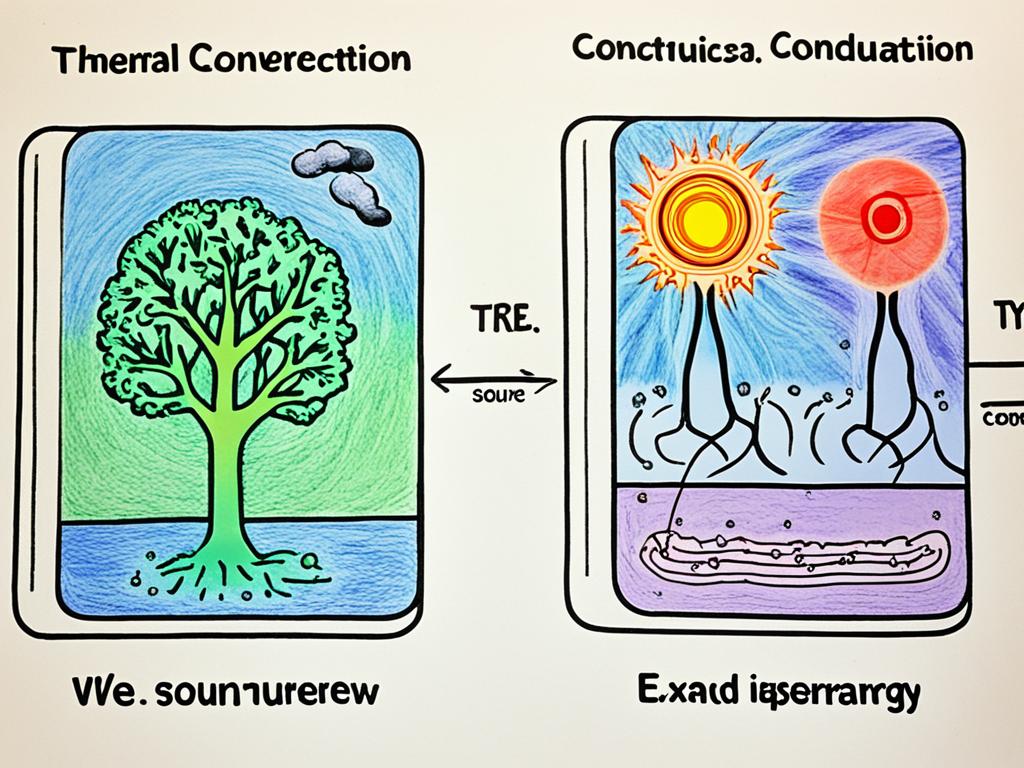Heat transfer is key to understanding how heat moves. It involves conduction, convection, and radiation. Each plays a big part in many activities and technological uses.
We can learn how these three methods affect everything. From tiny particle interactions to large-scale effects on weather and buildings. Knowing about heat transfer helps us use energy better and improve equipment and materials.
Key Takeaways
- Convection, conduction, and radiation are the three primary modes of heat transfer.
- Heat transfer fundamentals are crucial for various engineering and technological applications.
- Understanding thermal processes can optimize energy efficiency and material design.
- Conduction involves heat transfer through direct contact between materials.
- Convection transfers heat via fluid movement, including both liquids and gases.
- Radiation transfers heat without requiring a medium, through electromagnetic waves.
- Comprehensive knowledge of heat transfer enhances performance in numerous systems.
Understanding Heat Transfer
Heat transfer is key in science and engineering. It is about moving heat from warmer to cooler places. The Principles of Heat Transfer affect many everyday activities and industrial operations, being central in controlling temperature.
Definition of Heat Transfer
At its most basic, heat transfer is how thermal energy shifts due to temperature differences. It is vital in science and technology, helping develop many kinds of tech. Studying Heat Transfer science lets engineers and scientists make heating and cooling better and more efficient.
Importance of Heat Transfer in Daily Life
The Principles of Heat Transfer are everywhere in our lives. They are in cooking, in car engines, and in keeping electronics cool. Good heat transfer keeps our homes warm in winter without overheating our gadgets. It also pushes forward new, green energy technologies.
Looking closely at Thermal Energy Transfer lets us better design and use technology. This not only makes our lives more comfortable but also helps save energy and protect the environment.
Introduction to Thermal Energy
Thermal energy is key in both physics and engineering. It represents the total energy of moving particles in a substance. This energy affects many processes and systems in our lives.

What is Thermal Energy?
Thermal energy comes from the kinetic energy in particles. It happens due to the temperature of matter. When particles move faster, they create more thermal energy. This changes the state of the substance. Thermal energy is vital in natural and human-made thermal energy sources.
Relation Between Thermal Energy and Heat Transfer
Thermal energy and heat transfer are closely connected. When thermal energy goes up, substances can change from solid to liquid or gas. Heat transfer applications use this idea. They move heat from one place to another using conduction, convection, and radiation. These methods are crucial for using energy systems in various settings.
Mechanisms of Heat Transfer
It’s key to know how heat transfer works to get how heat spreads in different setups. There are three main ways heat moves: conduction, convection, and radiation. Each has its own features and uses.
Overview of Conduction, Convection, and Radiation
Conductive Heat Transfer is when heat goes through a material because its particles touch each other. Like in metals, they’re great at conducting since heat moves through them fast. This is key when you want heat to spread well inside a solid.
Convective Heat Movement is about heat moving through fluids, like liquids or gases. This happens because the fluid moves. For example, in heating systems and weather patterns, hot fluids go up, and cold ones go down. This makes a flow pattern.
Radiative Heat Exchange means heat travels through electromagnetic waves. Different from the first two, radiation doesn’t need anything to move through. It can even move through empty space. This is how the sun heats the Earth.
Comparison of Different Heat Transfer Mechanisms
To really understand how different these heat transfer methods are, looking at them side by side helps.
| Mechanism | Medium Required | Primary Mode | Typical Applications |
|---|---|---|---|
| Conductive Heat Transfer | Solid | Particle-to-particle contact | Metal cookware, thermal insulation |
| Convective Heat Movement | Fluid (liquid or gas) | Fluid motion | Weather systems, HVAC systems |
| Radiative Heat Exchange | Vacuum or air | Electromagnetic waves | Solar heating, infrared heaters |
Heat Transfer: Conduction, Convection, and Radiation
Thermal physics shows us how heat moves. It looks at heat transfer methods like conduction, convection, and radiation. These methods help us use and control heat better.
Conduction is when heat moves through direct touch. When things touch, energy spreads from one to another. It’s how hot plates cook food and how metals get hot near a flame.
Convection moves heat with fluids like air or water. It’s why the air around us and oceans move warm and cold around. Boiling water is a simple way to see convection at work.
Radiation sends heat with no need for contact, using waves. The sun warms our planet this way. It’s key to understanding how Earth stays warm.
- Heat Transfer Methods address different needs and scenarios.
- Theory in physics of heat transfer helps predict and innovate.
- Using thermal transfer techniques makes energy use better and materials last longer.
| Method | Mechanism | Applications |
|---|---|---|
| Conduction | Direct contact between particles | Cooking, metal processing |
| Convection | Movement within fluids | Weather systems, heating systems |
| Radiation | Electromagnetic waves | Solar energy, thermal imaging |
Learning thermal transfer techniques helps us create better systems. It cuts energy use and makes things sustainable in many areas. The quest to know more about physics of heat transfer brings new ways to save energy and innovate in materials.
Conduction
Conduction is when heat moves through materials. It needs a temperature difference, moving from hot to cold areas.
What is Conduction?
Heat moves by direct contact in conduction. When heat stirs up particles in a material, they bump into neighbors, passing on energy.
Examples of Conduction in Daily Life
Touching a hot pot or using a metal rod in a fire shows conduction. It shows how heat travels through stuff we use every day, like pots and tools.
Thermal Conductivity and Its -Role
How well a material conducts heat is its thermal conductivity. Metals are good at it, so we use them in kitchen gear and radiators. Insulating materials, though, block heat flow.
Fourier’s Law of Heat Conduction
Fourier’s Law in Action explains how materials transfer heat. It says the transfer speed depends on the temperature difference and how well the material conducts heat. This idea helps engineers calculate heat movement in objects.
Convection
Convection helps in moving heat using a fluid, like air or water. It’s a key idea in many areas, from weather forecasting to designing cooling systems for factories.

Principles of Convective Heat Transfer
Convective heat transfer moves heat in fluids, which can be liquids or gases. Heat moves because of temperature and density changes in the fluid. This creates a flow that helps spread heat.
Knowing how this works helps make better cooling systems and other tools for managing temperature.
Types of Convection: Natural and Forced
There are two main kinds of convection: natural and forced. Natural convection happens when heat makes fluid move by itself, because of changes in weight. Forced convection uses things like fans to move the fluid, helping to spread heat faster.
Both types are important for making things like weather control and cooling systems work well.
Newton’s Law of Cooling
Newton’s Law of Cooling talks about how fast something cools down. It says that if something’s hotter than its surroundings, it will cool quicker. This idea helps us control temperature in many situations, making sure things don’t get too hot or use too much energy.
Real-life Examples of Convection
Convection affects our world in big ways. For example, it shapes weather patterns, like sea breezes and thunderstorms, thanks to natural convection. At home, things like heaters and air conditioners use forced convection to keep us comfortable.
In industries, cooling systems work hard to keep machines at the right temperature. They use both natural and forced convection.
| Convection Type | Description | Applications |
|---|---|---|
| Natural Convection | Driven by buoyancy forces due to temperature-induced density differences | Weather patterns, ocean currents |
| Forced Convection | Enhances fluid movement using external forces like fans or pumps | HVAC systems, industrial cooling |
Radiation
Radiation transfers heat without needing a medium. This makes it crucial in nature and technology. Radiation sends out and catches electromagnetic waves. These include visible light and infrared radiation.
These waves move through space. That’s how the Sun heats the Earth. We call this solar heat transfer.
The Stefan-Boltzmann Law explains radiative heat transfer. It shows how hot and cold objects release energy. We feel this as the sun’s warmth on our skin or a campfire’s heat.
Looking at practical uses, we see solar panels. They use solar heat transfer to make electricity. Infrared heaters and night vision gear also rely on infrared radiation. They provide heat and help us see in the dark. Understanding electromagnetic waves is key to these technologies.
Radiative Heat Transfer
Radiative heat transfer is a key concept in thermal dynamics. It’s different from conduction and convection because it doesn’t need direct contact or fluid movement. Instead, it works through electromagnetic waves. This process explains how solar energy gets to Earth. It also shows how objects at different temperatures share heat.
Understanding Radiative Heat Transfer
This heat transfer is crucial for many natural and man-made processes. It happens without a physical medium, using electromagnetic waves. Think about the sun’s warmth from millions of miles away. That’s radiative heat transfer at work. Grasping this helps develop new solar energy technologies. It also improves thermal management in places from homes to spacecraft.
The Stefan-Boltzmann Law
The Stefan-Boltzmann Law is central to understanding radiative heat transfer. It says a blackbody’s emitted power relates to its temperature. Thanks to this law, we can figure out radiative transfer better. It’s key for designing systems that manage heat well. The law affects many areas, like creating satellites, high-tech devices, and energy-saving buildings. By using this law, we make big strides in technology and everyday life.


